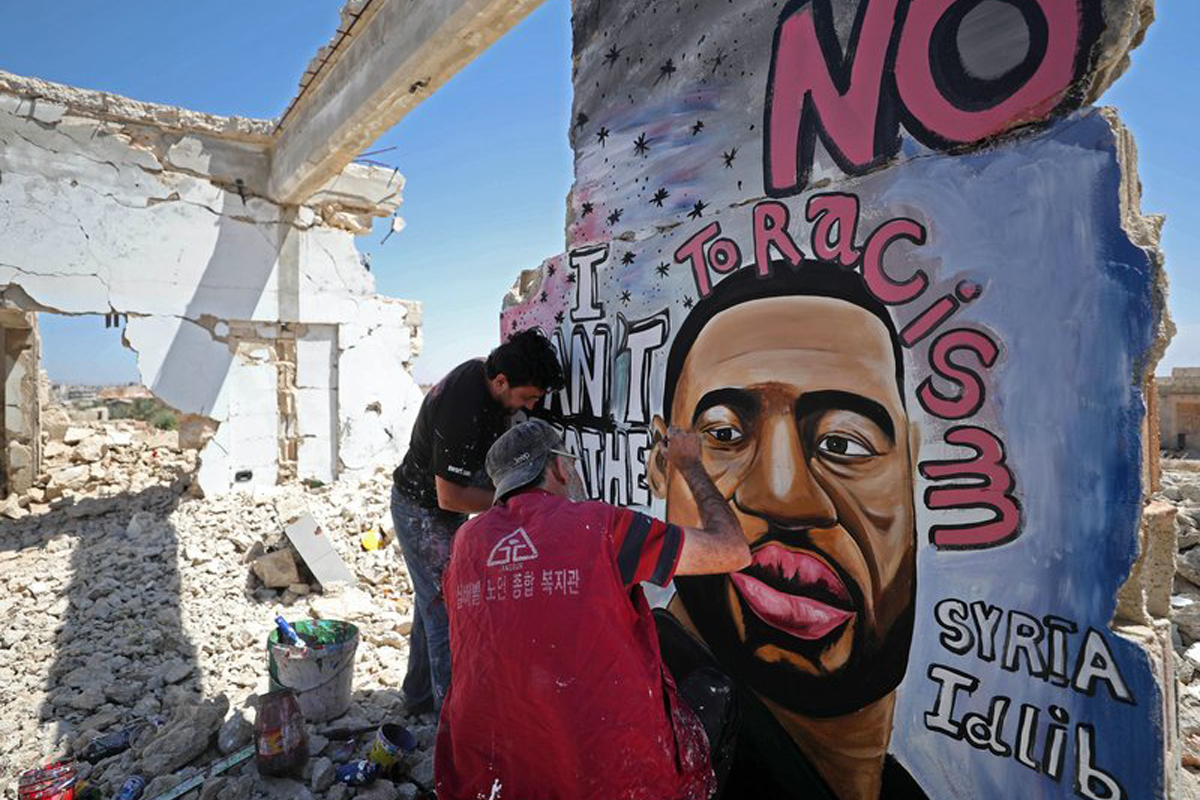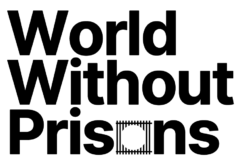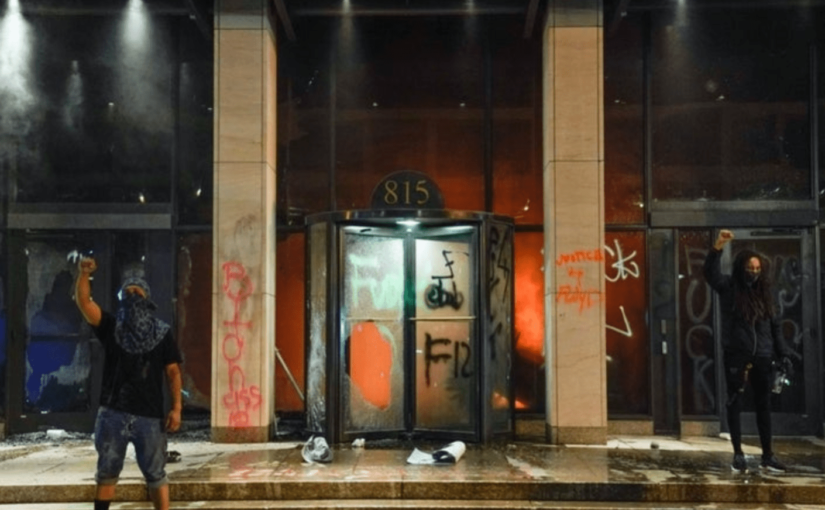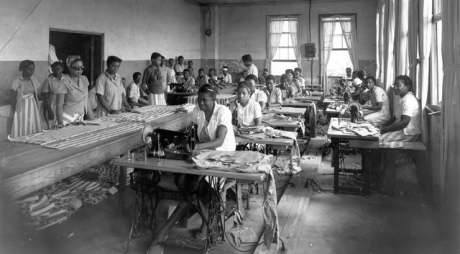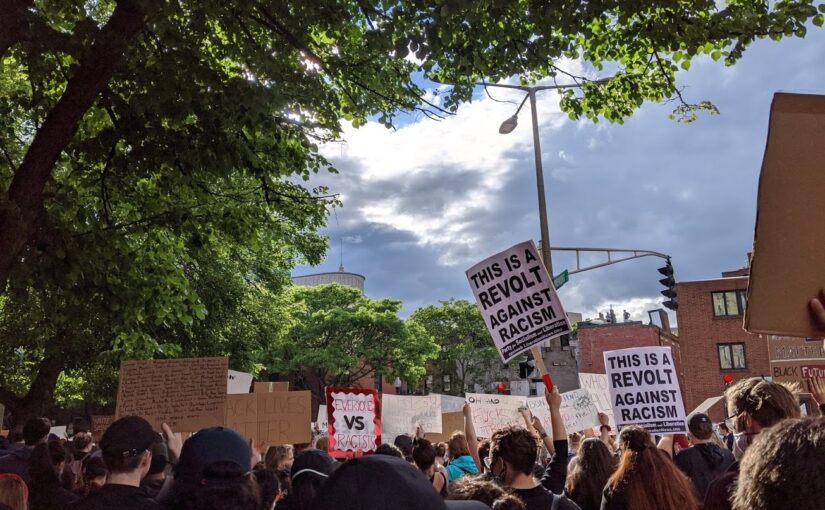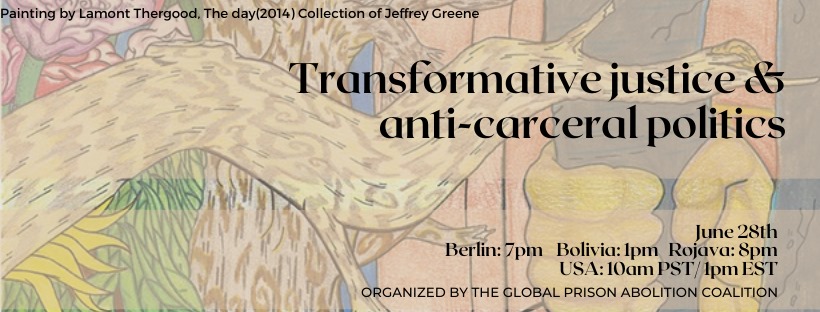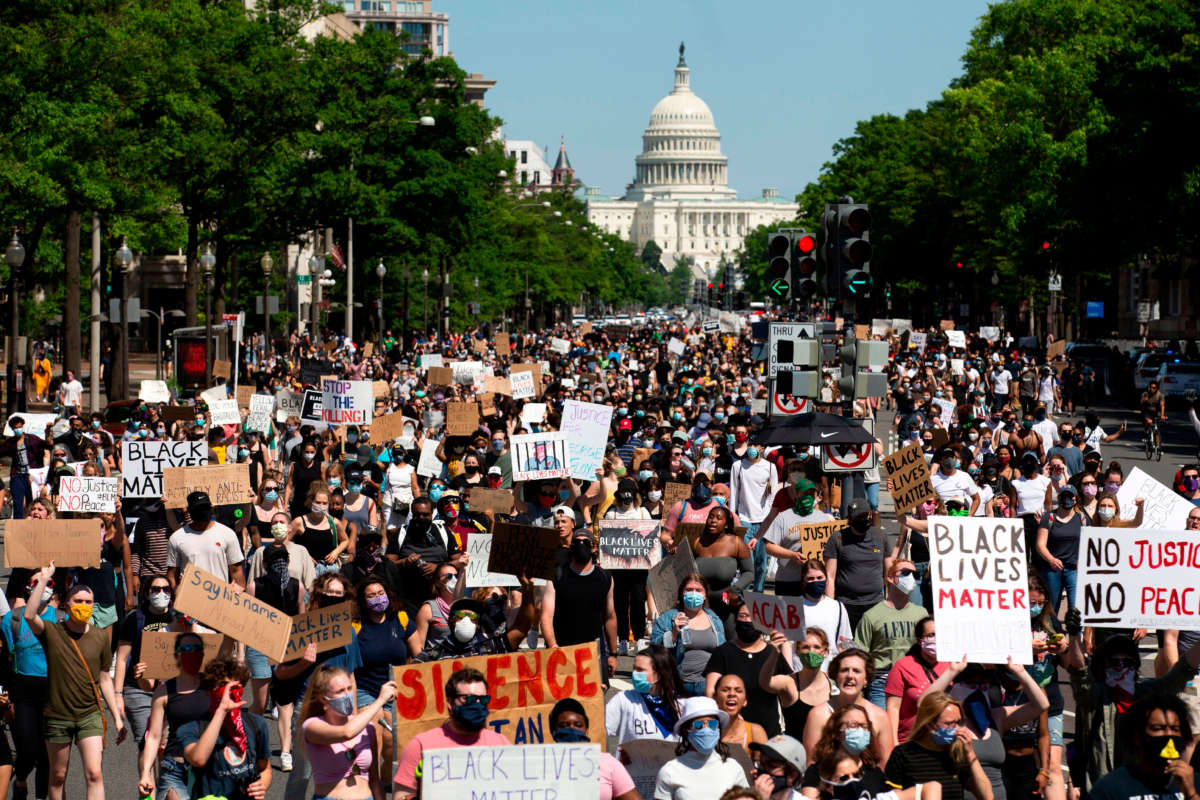Visit the website of the National Jericho Movement for the full list of political prisoners.
Category: USA
Pandemic sidelines more than 1,000 incarcerated wildfire fighters in California
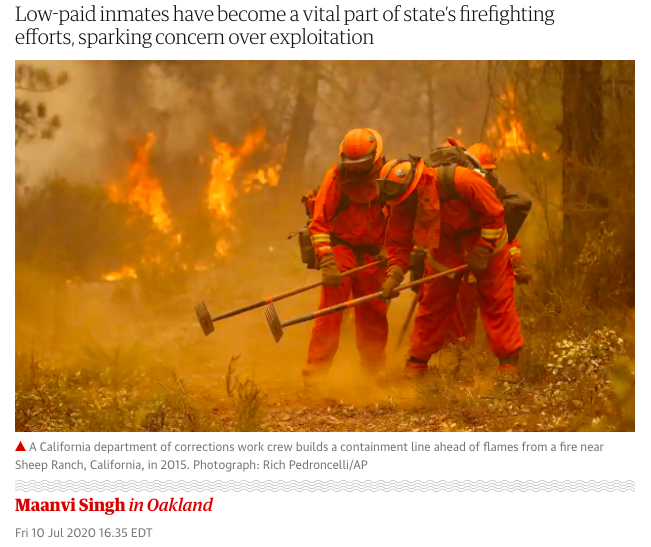
Our coalition’s member Dr. Romarilyn Ralston interviewed by Maanvi Singh for The Guardian, July 10, 2020
“Every fire season it’s the same,” said Romarilyn Ralston, who leads Project Rebound, a California State University program that supports formerly incarcerated students. “The pay is so little, the work is so dangerous. Now we add Covid-19 to the story, and it gets even worse.”
The crews are both crucial and heavily exploited, said Ralston, who worked at a fire camp while incarcerated. In exchange for extremely dangerous work, prisoners earn time off their sentences and are paid between $2 and $5 a day, plus $1 per hour when they are on a fire. Because incarcerated firefighters are paid so little, the program saves the state of California $90m to $100m a year.
“It’s a super imbalanced system; it’s much like the system of slavery,” said Deirdre Wilson, a master’s student of social work at the University of Southern California and a member of the California Coalition of Women Prisoners. “There’s a reliance on this population, on this cheap labor.”
Read the full article in The Guardian.
Black Lives Matter: We Remember George Floyd
By Robert Cuffy
Featured image, of a burning AFL-CIO headquarters in Washington, D.C., during protests on May 31, courtesy Evan Vucci/AP
Originally Published on Abolition Journal
“Knowing my brother is to love my brother.
“He’s a gentle giant, he don’t hurt anybody.” – Philonise Floyd.
The history of international capitalism is indissolubly bound up with the oppression of people of African descent. In the United States, Black people’s daily lived experiences are emblematic of the double edged sword of class exploitation and social oppression. Whereas in Britain the modern police force can trace its heritage back to strikebreaking thugs, in the United States the modern police force is directly descended from the slave patrols which terrorized slaves seeking freedom.
As the status of Black people in the US changed from slaves to “free” laborers through the heroic struggle of slave rebellions and the abolitionist movement, the slave patrols went through a parallel transformation into modern police officers who were employed not by individual plantation owners but by local, state and the federal government. These police officers, like their partners across the pond in Britain, also played a key role in suppressing labor struggles and today remain the government’s favored strikebreakers.
Time and time again, as Black people have stood up for their rights in the United States, they have been met with exceptionally brutal and murderous responses from the government. Yet such violence is not reserved solely for periods of upsurges in the Black struggle, it is embedded into the daily fabric of Black life.
The May 25th murder of George Floyd by the Minneapolis Police Department (MPD) , for the alleged crime of using counterfeit currency, is a prime example of the fact that Black people live heavily policed lives with the ever present possibility of being murdered at the drop of a dime. Watching the footage of MPD officer Chauvin kneeling on Floyd’s neck for eight full minutes should fill the average person with a burning rage due to the callous indifference shown to George’s life. It is this burning rage which the Black youth of Minneapolis unleashed upon targets in their city which were identified with the daily oppression.
Minneapolis’ Black youth held protest rallies, marches and in some instances burned police precincts to the ground. The fire this time was especially fueled by the global Covid-19 pandemic which has devastated the world and has disproportionately killed and sickened Black people in the US. Further kindling was added to the blaze when the everyday repressive role of the police in Black neighborhoods was reconfigured into the enforcement of social distancing guidelines during the lockdown.
Yet in Minneapolis, the problems in the lives of Black people run much deeper. As the New York Times explained, in Minneapolis, “Decades of government policy and private-sector decisions have given benefits to white families that black families haven’t received.” This has created a tale of two cities: a white city with one of the country’s highest standards of living by many measures: high incomes, long life expectancy, a large number of corporate headquarters and a rich cultural scene. Then there is the Black Minneapolis which is residentially segregated into a ghetto where the Minneapolis Police Department is known to patrol like a modern day Gestapo.
It is these daily conditions of humiliation and frustration which drove the protestors to say no more and since mistreatment by the police is a shared experience of Black people in the US, the movement spread across the country like wildfire with mass marches held in major cities and even in small towns. With the open white supremacist Donald Trump as president of the United States, both the vigilantes and law enforcement officers who support him have been emboldened to treat people of color, and Black people especially with impunity. The recently publicized vigilante lynching of Ahmaud Arbery in Georgia and the no-knock warrant police murder of Breonna Taylor in Kentucky also gave special urgency to the movement.
Incredibly, since May 25th there have been several other high profile police killings of unarmed Black people including that of trans man Tony McDade in Florida on May 27 and David McAtee in Louisville on June 1st. Police have also been filmed using pepper spray, teargas, rubber bullets and their batons to assault and arrest protestors. In Minneapolis the national guard was called to the city in echoes of the Baltimore, MD and Ferguson, MO uprisings against the police murders of Freddie Gray and Michael Brown during the initial wave of Black Lives Matter rebellions five years ago.
Undeterred by this excessive display and use of military might, the youth have continued to lead the fight. President Trump ran scared to a bunker after protestors surrounded the White House. Trump would later violently clear protestors and promised an aggressive military response, but by this time the movement was in full swing and the Black youth were joined in the streets by a multiracial alliance of protestors. Even the US’ unions, which are often indifferent to issues of racial justice, have been pushed to issue statements in support of the movement. In both Minneapolis and New York City bus drivers have refused to transport arrested protestors to jail and have been supported by their union leaders.
The actions of these rank and file bus drivers contrast with the words of Richard Trumka, the president of the United State’s largest union body, the American Federation of Labor-Congress of Industrial Organization (AFL-CIO). On May 30th, 2020 Trumka appeared on the conservative site Fox News where he acknowledged that “racism plays an insidious role in the daily lives of working people of color” but also called the militant actions of some protesters “irresponsible and reprehensible which perpetuates violence.” One day later, on May 31st, some of those allegedly “irresponsible and reprehensible” acts were visited upon the headquarters of the AFL-CIO in DC which prompted Trumka to finally issue a statement in support of justice for George Floyd.
The statement repeated Trumka’s aforementioned characterization of the protest violence but acknowledged, “…the labor movement is not a building. We are a living collection of working people who will never stop fighting for economic, social and racial justice” while also pledging: “We will clean up the glass, sweep away the ashes and keep doing our part to bring a better day out of this hour of darkness and despair.” In some radical circles in the United States there’s a conception that “Labor must take the lead” over the struggles of the oppressed; however, the mass militant demonstrations and rebellions which have erupted in the last week shows that the logic of the class struggle is very different. As Trinidadian scholar CLR James explained, the Black struggle “is able to intervene with terrific force upon the general social and political life of the nation, despite the fact that it is waged under the banner of democratic rights, and is not led necessarily either by the organized labor movement or the Marxist party.”
James wrote those words seventy-two years ago and they remain valid today because they are being actualized in the lived experiences of the class struggle. This pressure exerted upon the union leaders by the Black youth expressing outrage against police terror has also inspired grassroots union activity. For example, a leader of the Amalgamated Transit Workers Union in Minneapolis started the Facebook Group called Union Members for #JusticeForGeorgeFloyd as well as launched a petition for union members to show solidarity and June 9th, the International Longshore Workers Union organized an eight minute work stoppage in acknowledgement of the time killer cop Chauvin spent kneeling on Floyd’s neck. The protest movement has also created momentum within the labor movement to finally kick the racist cops out of our unions and has generated increased support for the demand to defund the police. Incredibly, the Minneapolis City Council has even voted to disband the current police force.
New life has also been breathed into the movement towards police abolition. It has come at the great sacrifice of those brave young people who have put their lives on the frontlines, many of whom have been violently arrested and some have even been killed by police. The solidarity expressed from non-Black and older protesters has been so overwhelming that it has manifested a shift in national consciousness. According to the New York Times, over the last four years there has been a jump from 34 to 57 percent of the population who believe “the police were more likely to mistreat black people than to mistreat white people.”
This shift in consciousness, the activation of the masses against police brutality and the wider ills of capitalism, amplified under the Covid-19 pandemic has also had international reverberations. In France, Brazil, Jamaica, Africa and many other parts of the world protests have erupted against racism and in solidarity with justice for George Floyd. The open white supremacist presidency of Trump in the US also has parallels with a rising trend of authoritarian leaders throughout the world. The fact that the Minneapolis rebellion is inspiring solidarity struggles worldwide against police brutality can open the door to international struggles against authoritarianism. The United States sees itself at the center of the imperialist world and if the movement on the streets keeps sending Trump running to a bunker and building a wall around the White House, it may inspire working class and oppressed people in their respective countries to find the confidence to stand up to their own dictators. This would be a fitting tribute to George Floyd whose name shall live forever in the annals of struggles against injustice. The Transnational Solidarity Network will continue to #SayHisName until his murderer Chauvin is behind bars!
Justice for
#GeorgeFloyd
#BreonnaTaylor
#AhmaudArbery
#TonyMcDade
#JamalFloyd
#DavidMcAtee
The Architects of Abolitionism: Joy James
Revisiting the Prison Industrial Complex
Originally published in OpenDemocracy
Authoritarian capitalism and the prison industrial complex is a two-tiered tyrannical system designed to enslave through mass incarceration.

Children with incarcerated parents are 6-9 times more likely to become incarcerated themselves. Black children are seven-and-a-half times more likely than White children to have a parent in prison, and Latino children are two-and-a-half times more likely to experience this family dynamic.
In 2000, in Masked Racism: Reflections on the Prison Industrial Complex, Angela Yvonne Davis examined the infamy of the Prison Industrial Complex (PIC), a term first coined, maybe by Angela Davis herself, in the late 1990’s. What is the PIC? It is a term used to describe the overlapping interests of government and industry that use surveillance, policing and imprisonment as solutions to economic, social and political problems. Davis stated:
“Prison privatization is the most obvious instance of capital’s current movement toward the prison industry. While government-run prisons are often in gross violation of international human rights standards, private prisons are even less accountable. In March 1998, the Corrections Corporation of America (CCA), the largest US private prison company, claimed 54,944 beds in 68 facilities under contract or development in the US, Puerto Rico, the United Kingdom, and Australia. Following the global trend of subjecting more women to public punishment, CCA opened a women’s prison outside Melbourne.
Private prison companies are only the most visible component of the increasing corporatization of punishment. Many corporations whose products we consume on a daily basis have learned that prison labor can be as profitable as third world labor power exploited by US-based global corporations. Both relegate formerly unionized workers to joblessness and many even wind up in prison. Some of the companies that use prison labor are IBM, Motorola, Compaq, Texas Instruments, Honeywell, Microsoft, and Boeing. But it is not only the hi-tech industries that reap the profits of prison labor.
The California Prison Industry Authority (CALPIA) uses inmate labor to build, grow, and manufacture products for state agencies, institutions and schools. Products such as furniture, food products & agriculture, clothing, bedding, shoes & boots, and more. The 2016 revenue earned by PIA was approximately 225M, while inmates work pay ranges from .32-$1 per hour.
- PIA Mission Statement: CALPIA is a self-supporting, customer-focused business that reduces recidivism, increases prison safety, and enhances public safety by providing offenders productive work and training opportunities.
- Vision Statement: Changing offenders’ lives through innovative job training for a safer California.
While these messages may be the mission and vision of CalPIA, the training provided seldom if ever leads to work post-release. Unemployment and underemployment are the biggest barriers to successful reentry.”
Davis continued:
“Nordstrom department stores sell jeans that are marketed as “Prison Blues”, as well as t-shirts and jackets made in Oregon prisons. The advertising slogan for these clothes is “made on the inside to be worn on the outside”. Maryland prisoners inspect glass bottles and jars used by Revlon and Pierre Cardin, and schools throughout the world buy graduation caps and gowns made by South Carolina prisoners. “For private business”, write Eve Goldberg and Linda Evans (a political prisoner inside the Federal Correctional Institution at Dublin, California) “prison labor is like a pot of gold. No strikes. No union organizing. No health benefits, unemployment insurance, or workers’ compensation to pay. No language barriers, as in foreign countries. Prisoners do data entry for Chevron, make telephone reservations for airlines, raise hogs, shovel manure, make circuit boards, limousines, waterbeds, and lingerie for Victoria’s Secret all at a fraction of the cost of `free labor'”.
As a youth, I was arrested and convicted of a crime and sentenced to life in prison. I served 23 years at the California Institution for women in Corona, CA. When I was first incarcerated in 1988, the women’s prison in Corona was the largest women’s prison in the world. Since the 1980s prison expansion in California CIW has become second to the California Central Women’s Facility in Chowchilla which opened in 1991. We often saw tours given to visitors from other countries who were looking to CIW as a model to emulate. Many countries now look away from the American carceral system as a model, seeing prison expansion and mass incarceration of its citizens as disgraceful and a human rights violation.
CIW was built in 1952 to hold approximately 500 women. When I arrived, there were 2800 female bodied prisoners packed into converted dayrooms, custodial boiler rooms, doubled bunked cells, and the auditorium. From the vast number of women locked up, it was clear that CDC was only interested in human capital as a means of profiteering. The majority of women behind bars were convicted of drug-related and property crimes. Black women made up 47% of the population in 1988 and continued to grow through the late 1990s.
By the time I was released in 2011 Black women made up approximately 37% of the population behind bars a decrease of 10% but still a disproportionate number in relationship to the general population. Thanks to prison abolitionists, criminal justice reformists and policy changes, black women are less impacted today. However, the damage has been done and the cycle of generational poverty and incarceration is still high for black Americans.
To further illustrate these remarks Davis points out:
“To deliver up bodies destined for profitable punishment, the political economy of prisons relies on racialized assumptions of criminality – such as images of black welfare mothers reproducing criminal children – and on racist practices in arrest, conviction, and sentencing patterns. Colored bodies constitute the main human raw material in this vast experiment to disappear the major social problems of our time. Homelessness, unemployment, drug addiction, mental illness, and illiteracy are only a few of the problems that disappear from public view when the human beings contending with them are relegated to cages. Prisons thus perform a feat of magic.
“But prisons do not disappear problems, they disappear human beings. And the practice of disappearing vast numbers of people from poor, immigrant, and racially marginalized communities has literally become a big business. Once the aura of magic is stripped away from the imprisonment solution, what is revealed is racism, class bias, and the parasitic seduction of capitalist profit. The prison industrial system materially and morally impoverishes its inhabitants and devours the social wealth needed to address the very problems that have led to spiraling numbers of prisoners.”
The prison industrial complex is a business!
The impact and intersection of race, mass incarceration, state violence and authoritarian capitalism can be seen and felt in places like Ferguson, Missouri. After the murder of Michael Brown, Jr, an unarmed black teenager in Ferguson, Missouri by Darren Wilson, a white police office, the world witnessed the use of military force and weaponry on US soil against peaceful protesters and on American citizens like never before.
I was living in North County St. Louis when all this happened. I protested, attended rallies, and volunteered with the Ferguson Commission, a body of 16 local leaders. The charge was to address the underlying root cause that led to the unrest in the wake of Michael Brown’s death and to publish a report with transformative policy recommendations for making the region stronger and a better place for everyone to live and to guide the community in charting a new path toward healing and positive change for all residents of the St. Louis region.
We know the 2015 report concluded what most reports have concluded after investigating the cause of unrest in Black communities over the past century (i.e., East St. Louis (1917), Watts (1965), Detroit (1967), and Los Angeles (1992)). Strategies for healing racial wounds, dismantling structural racism, and promoting racial and ethnic equity are needed but never produced.
The continuous mistreatment, torture, terrorism, and murder of Blacks in America as sanctioned by State violence and white supremacy have been normalized by authoritarian capitalism.
Not much has changed in St. Louis since August 9, 2014. On September 15, 2017 another White police officer (ex-police officer) Jason Stockley was acquitted for killing Anthony Lamar Smith (24 yrs. old) after being caught on tape stating: “I’m going to kill the nigger,” despite the investigation concluding that he had planted a firearm in Smith’s car.
Authoritarian capitalism and the prison industrial complex is a two-tiered tyrannical system designed to enslave through mass incarceration. The white imagination that sees black people as less than human, sees poor people as slaves, and profit as justice.
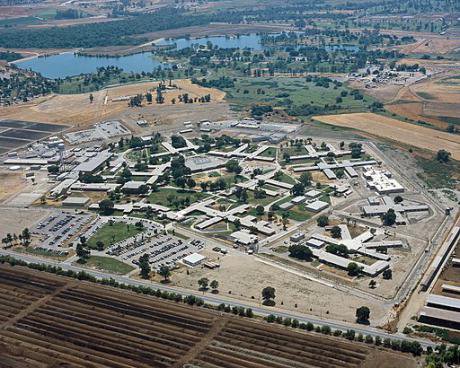
Support Jalil Muntaqim’s Medical Parole and Commutation of his Sentence
To: New York State Governor Andrew Cuomo New York State Department of Corrections and Community Supervision (DOCCS) Commissioner Anthony Annucci
Campaign created by Northeast Political Prisoner Coalition
Originally published on OrganizeFor
We strongly support Medical Parole and the Commutation to time served for Jalil Muntaquim. We are confident that his release poses no danger to our communities, and we urge you to allow him to rejoin his family and friends.
Why is this important?
Widely respected elder Jalil Muntaqim (Anthony Bottom) joined the Black Panther Party at age 16 and was arrested at age 19. Jalil is in his 49th year of incarceration, currently held at Sullivan Correctional Facility on a 25-years to life, minimum sentence. Jalil became ill and contracted COVID-19 in May 2020. Jalil falls into two of the highest risk categories due to his age and his medical conditions, which include chronic bronchitis, heart disease, and hypertension. He also has previously suffered a stroke with some resulting brain damage, and has scarring in his lungs as a result of a case of tuberculosis in his youth. As a result of his pre-existing health conditions, Jalil has been fighting for his life.
In an effort to avoid contracting the virus, Muntaqim initially appealed to the court for relief. On April 27th, the New York State Supreme Court granted him temporary release from prison. The order did not release him completely, as he would still be serving his sentence under DOCCS supervision. However, Attorney General Letitia James appealed the Judge’s decision, forcing Jalil to remain incarcerated. A few weeks later Jalil contracted COVID-19, as he had feared.
Jalil has an exemplary record and a reputation as a peacemaker and teacher. Our biggest fear is that if he is not released, his prison sentence will become a death sentence. At a time when people are taking to the streets to protest state violence against Black people, the Black lives of those who fought to protect Black communities from police brutality and murder should not be disregarded.
Visit the campaign site to sign the petition.
We can’t let China apologists stop us from supporting Black Lives Matter
Building global solidarity is necessary to fight the global conditions of our struggles.
By JN Chien and JSon June 18, 2020
Read the article in Chinese.
Originally published in Lausan
The Sunrise Movement, a youth-led climate organization, had plans to host an exchange with a Hong Kong activist called “Learning From Hong Kong.” The idea was to look comparatively at Hong Kong’s past year of resistance to share strategies with activists in the US joining Black Lives Matter protests.
When Sunrise Movement announced their event on Twitter, a faction of the Western Left flooded the comments with vitriol. One commenter, who had misidentified the guest panelist Johnson Yeung as Joshua Wong, shared pictures of the latter shaking hands with conservative politicians such as Marco Rubio and Josh Hawley. Others were quick to point out that Yeung had received funding from the National Endowment for Democracy (NED). Another commenter even tweeted that the Hong Kong movement is an “insurgency [that] is led by right-wing pro-colonialist advocates who collaborate with racist Republicans.” Their motivation was clear: to discredit the Hong Kong movement and bully Sunrise Movement into cancelling the event.
The criticism of the event comes from a particular faction of the Left who parochially believe that any foreign state expressing any anti-US sentiment is worth supporting because they undermine US imperialism. As Vincent Wong explains, these groups “leverage the lack of trust with Western governments but perverts it to such an extent that it cannot deal with the possibility that there could be terrible repression or injustice in the absence of the US boogeyman.” As a result, they align with authoritarian regimes such as the Chinese Communist Party and the DPRK. Despite claiming to be leftists, this political view has resulted in odd commentary on the Hong Kong movement, such as support for police violence and condemnation of millions of Hongkongers’ demand for democracy.
It is important, however, to recognize that the US flag-waving Trump supporters in Hong Kong are real. Some Hongkongers have also pinned their hopes on lobbying the US. But these groups only make up a small section of the overall movement. Likewise, it would be dishonest to discredit the ongoing Black Lives Matter movement in the US just because the fascist white supremacist Boogaloo Boys have turned up at actions to co-opt anti-police, abolitionist struggles.
To point out NED’s minimal involvement in the Hong Kong movement in order to discredit Sunrise Movement’s event seems to signal something other than an issue with “foreign intervention”—namely the belief that Hong Kong people have no actual political agency (or contradictions, or tensions) in their struggle because they’re one homogenous mass. The idea that millions of people partaking in ongoing protests is impossible unless backed by the CIA supports the same infantilizing racism that considers all Chinese international students to be mindless agents of the CCP.
Indeed, it should be emphasized that the Hong Kong movement has no “leaders,” meaning that there is no political party or ideological faction issuing commands. This means that the continual, inaccurate assessment of Joshua Wong and others such as Johnson Yeung as “leaders” of the Hong Kong protests is completely disconnected from the most basic realities of the movement. These and other such inaccuracies often fly directly in the face of fact, and exploit reflexive reactions to further build out these China apologists’ own sense of credibility.
While the Hong Kong movement is far from perfect, these accusations against Sunrise Movement’s “Learn from Hong Kong” event, which claim that the entire Hong Kong movement is aligned with Trump and other right-wing Republicans, stem from a fundamentally racist logic that strips Hongkongers of their political agency.
Just as the US movement is ideologically diverse, Hong Kong leftists also occupy a small section of the Hong Kong movement, and have put decades of work into fighting the hyper-capitalist conditions of the city wrought by not only the US and Britain but now the PRC as well. These leftists have long done the dangerous work of supporting mainland activists struggling for political freedoms and better labor conditions. They have also already exchanged ideas with the Black Lives Matter movement such as sharing tips to defuse tear gas and circulating tutorials to build street barricades.
Letting pro-CCP nationalists on the Western left discredit other social movements—especially movements that are also fighting against police violence—is not the path forward. Instead, the transnational exchange of new strategies of resistance to militarized police brutality is an avenue to tangibly support movements against state violence—most pressingly now, amid the movement for Black liberation. In the end, the Sunrise Movement’s response to this social media controversy was the correct one: we must center Black lives and focus our attention on opposing anti-black violence everywhere.
Transformative justice & anti-carceral politics
The Global Prison Abolition Coalition invites you to a panel on Transformative Justice and anti-carceral politics.
The main driver behind the public’s rejection to abolitionist movements is the fear that there might be no alternative to prisons. This notion widely pushed by the state as well as other institutions that benefit from the carceral system is not true. There are alternative ways to think about justice beyond prisons and state punishment. This panel will address one such alternative: Transformative Justice (TJ).
Transformative Justice entails a political approach that seeks to build a anti-carceral politics while engaging in harm/violence reduction. This panel will unpack different understandings of abolitionism generated from an internationalist & anti-capitalist politics. The speakers will explore the history and significance of TJ in three locations, namely, Bolivia, Rojava in Northern Syria, and the United States.
https://www.facebook.com/events/914916035657763/
Speakers:
Joy James is the F.C. Oakley Professor in Humanities at Williams College, where she teaches in Political Science, Africana Studies, Women and Gender Studies, and American Studies. She is the author of Shadowboxing: Representations of Black Feminist Politics and Resisting State Violence: Radicalism, Gender and Race in U.S. Culture. Her edited books include The New Abolitionists: (Neo)Slave Narratives and Contemporary Prison Writings, Imprisoned Intellectuals, States of Confinement, The Black Feminist Reader, and The Angela Y. Davis Reader.
Nazan Üstündağ received her Ph.D. in 2005 from the sociology department at Indiana University Bloomington. Between 2005 and 2018, she worked as an Assistant Professor at Boğaziçi University, Department of Sociology. Since 2018, she resides in Berlin first as an Academy in Exile and IIE-Scholar Rescue Fund fellow and then as a Gerda Henkel Stiftung Patromonies Program fellow. Her most recent academic articles on state violence and Kurdish Movement appeared in journals South Atlantic Quarterly, History of the Present and Differences. She also worked as columnist in the journal Nokta and the newspaper Özgür Gündem. Üstündağ is a member of Women for Peace and Academics for Peace. Recently, she is finishing a book manuscript with the working title Mother, Politician and Guerilla: The Emergence of A New Political Cosmology in Kurdistan Through Women’s Bodies and Speech.
Raúl Zibechi is a Uruguayan journalist and one of Latin America’s leading political theorists. He is an international analyst for newspapers like La Jornada (Mexico) and Brecha (Uruguay), and a professor at the Multiversidad Franciscana de América Latina. Zibechi has written numerous books on social movements and politics across the Americas, including Territories in Resistance: A Cartography of Latin American Social Movements (AK Press, 2012) and Dispersing Power: Social Movements as Anti-State Forces (AK Press, 2010).
Moderator and Translator: The panel is moderated and translated by Linda Quiquivix who is a popular educator, geographer, and translator based in California. Linda Quiquivix (“Kiki”) is daughter of the undocumented migrant community in California and granddaughter of the Mam (Maya) people of Guatemala and Mexico. She places her university training as a geographer at the service of under-resourced communities in Palestine, Mexico, and the U.S. who seek clean water, land, and tools to build autonomy. In her hometown of Oxnard, California, she is part of a collective of seed savers and farmers who intervene against food insecurity, rebuild respectful ecological relationships to Mother Earth, and collectively organize toward climate resilience. She’s also a writer and researcher, currently working on a book manuscript entitled. Palestine and the Wretched of Empire: Race, Cartography, and the Afterlives of 1492, which traces the uses of cartography and international law in Palestine/Israel to show how movement leaders come to replicate domination when the world of empire becomes the starting point for politics.
Standing With Black Lives Matter Protests: Opposing Police Brutality, Militarism, and All Forms of State Violence
Frieda Afary, Sara Abbas and Yasser Munif
The video of a white police officer pressing his knee on the throat of George Floyd, a Black man for eight minutes and killing him, demonstrates the reality of white supremacy and the legacy of slavery in the U.S. George Floyd was lynched by police officers while some bystanders stood by and watched. Others on the scene protested and a young woman filmed the murder.
The truth is that the leading cause of death for young Black men in the U.S. is police killing. Not one week goes by without several unarmed Black individuals being killed by the police. This state-sanctioned violence against Black bodies is the vilest aspect of racial capitalism. In fact, racist violence and brutality against people of African descent is not just an issue in the U.S. but exists everywhere. It is urgent for global activists to combat that in their own countries and communities.
Scenes of multiracial protests and street battles against police brutality and state violence in Minneapolis and more than 140 U.S. cities reveal that there is something new emerging in the U.S.: A powerful movement against the police’s systematic killing of Black men and women. It is also a movement inspiring solidarity protests of thousands in other countries, who are declaring loudly and clearly: Black Lives Matter!
As the openly white supremacist Trump administration is using his racist base and machine gun-wielding thugs to push workers to go back to work despite unsafe working conditions in the middle of a pandemic, and now threatening to launch a full-scale assault of the U.S. military on the protesters, there are groups of people of all races coming together to protest white supremacy, police brutality and systemic violence. It is Black people however who remain at the helm of these protests as they fight, quite literally, for their lives.
While some protesters are calling for a complete defunding of the police and the use of those resources instead to help communities that have long been exploited, neglected and targeted with state violence, most are demanding much more. At a rally in Minneapolis on 30 May 2020, activist Tamika Mallory made a powerful speech: “This is not just a few cops doing things across the country. This is not a good cop versus bad cop situation. This is Ahmaud Arbery being shot down by white men on the streets of Georgia. Breonna Taylor being killed in her home. This is in New York City… we were just in New York, fighting the police officers, who in the name of social distancing were damn near killing Black young people on our streets. This is a coordinated activity happening across this nation, and so we are in a state of emergency. Black people are dying in a state of emergency.” The state of emergency extends to the Covid-19 pandemic, which reveals once more that Black lives are expendable to the white supremacist power structure on which the U.S. rests. Figures compiled by the non-partisan APM Research Lab and released just a few days before Mallory’s speech provide evidence of the monumental divide in the Covid-19 death rate between Black Americans and the rest of the country. African Americans have died at a rate of 50.3 per 100,000 people, compared with 20.7 for whites, 22.9 for Latinos and 22.7 for Asian Americans.
For this reason and many others, Black protesters say that getting rid of Trump and his administration is simply not enough. There has to be a complete and fundamental change in race relations, social and economic relations in the U.S.
In the meantime, Trump is using the intensifying capitalist competition and war threats with China to turn attention away from the deep crises at home and globally. Both the U.S. and China are instrumentalizing the pandemic to increase state security and authoritarian rule. In China, the state silenced frontline healthcare workers who warned about the rise of the coronavirus epidemic in December 2019. China is also where Africans have faced intense racism during the pandemic. In the U.S., the Trump administration denied the seriousness of the pandemic and then refused to coordinate the effort to stop the disease’s spread and to provide testing, safety, protective equipment for workers on the frontlines and basic needs and healthcare for the population. This has resulted in a catastrophe with more than 100,000 people having died from Covid-19 in the U.S. up to now. The U.S. accounts for only 4% of the global population and 30% of the Covid-19 deaths, putting it ahead of any country. To conceal their incompetence in addressing the pandemic, both the U.S. and China are accusing each other of negligence and corruption and each is using disinformation to promote lies, claiming that the coronavirus was made in a lab to wreck havoc on the other.
Although street protests without a genuine alternative to this inhuman capitalist racist sexist system are not enough on their own to overcome this ominous reality, it is very inspiring to see that youth and dispossessed communities around the world, through their creative and tech-savvy struggles, are building networks of solidarity across national borders. The U.S. protests against the murder of Floyd, Arbery and Taylor and more generally against state violence, represent a new hope for people around the world.
Juliana Goes, a Brazilian activist, draws comparisons between the systematic murder of Blacks by US police and the killing of Afro-Brazilians by Brazilian police. She writes: “In recent days, resistance by Black people has taken different forms. In Brazil, more than 800 organizations, brought together by the Black Coalition for Rights, protested the death of João Pedro, a fourteen-year old Black teen who was killed in his home’s living room when the police came in, shot him and disappeared with him.“ (See article by Juliana Goes elsewhere on this website)
There are long lasting relationships between the U.S. and Brazilian Afro-descendant communities which the recent protests in both countries will hopefully further consolidate.
Many Iranian activists inside Iran are also following the protests in the U.S. closely. The writers of Sarkhat, a progressive underground Telegram station, draw connections between the murder of George Floyd and the Iranian police murder of poor and dispossessed women or Afghan refugees or the Iranian state’s brutal repression of a popular uprising in November 2019. Many youth oppose the Iranian government’s repression, and also oppose Trump, U.S. imperialism, capitalism and white supremacy.
It is in the spirit of bringing these and other global struggles together and developing their revolutionary potential that the Global Prison Abolitionist Coalition was formed.
This coalition brings together the expertise and knowledge of socialist and abolitionist groups and individuals who struggle against racism, police brutality, state violence and the carceral system in different regions and joins that effort with a dialogue on alternatives to capitalism, racism, sexism, heterosexism and all forms of dehumanization.
We invite individuals and organizations who are interested in participating in this effort to read our statement of purpose and contact us.
